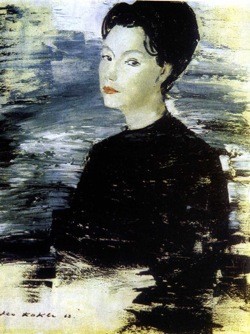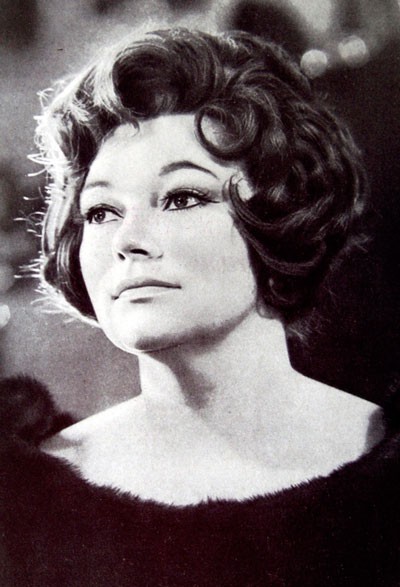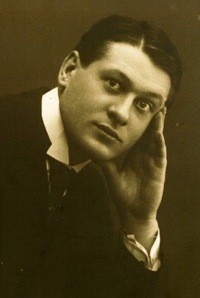
Bela Andreevna Rudenko |
Bela Rudenko

Among the works of the Latvian artist Leo Kokle, there is a portrait in soft blue pastel colors that involuntarily attracts attention. On a refined face, piercingly distinct eyes are huge, dark brown, attentive, inquiring and anxious. This is a portrait of the People’s Artist of the USSR B. A. Rudenko. Leo Coquelet, an observant and thoughtful artist, managed to capture the main thing that distinguishes her character – femininity, softness, lyricism and, at the same time, composure, restraint, purposefulness. The interweaving of such, at first glance, contradictory features created that fertile ground on which a bright and original talent grew up …
The singer’s creative biography began at the Odessa Conservatory, where, under the guidance of O. N. Blagovidova, she learned the first secrets of musical mastery, took her first life lessons. Bela Rudenko’s mentor was distinguished by delicacy and careful attitude towards the vocalist, but at the same time, strict exactingness. She demanded complete dedication in work, the ability to subordinate everything in life to the service of the muse. And when the young vocalist in 1957 became the winner at the VI World Festival of Democratic Youth and Students, having received a gold medal and an invitation to concert performances in Moscow and Leningrad with Tito Skipa, she took it as an exit to the wide road, which obliges a lot.
Every true master is characterized by restlessness, dissatisfaction with what has been done, in a word, something that encourages constant introspection and creative search. This is precisely the artistic nature of Bela Andreevna. After the next concert or performance, you meet a serious, collected interlocutor who is waiting for a strict and truthful assessment, an assessment that, perhaps, will give impetus to new thoughts and new discoveries. In this never-ending process of analysis, in constant search, lies the secret of renewal and creative youth of the artist.
“Bela Rudenko grew from role to role, from performance to performance. Her movement was gradual – without jumps, but without breakdowns either. Her ascent to the musical Olympus has been steady; she did not soar rapidly, but rose, stubbornly conquering new heights in each new party, and that is why her high art and her outstanding successes are so simple and confident, ”wrote Professor V. Tolba about the singer.
On the stage, Bela Andreevna is modest and natural, and this is how she conquers the audience, turns it into her creative ally. No affectation and the imposition of their tastes. Rather, it is the joy of empathy, an atmosphere of complete trust. Everything that has been living for more than one century, Rudenko always opens for himself and for others as a new page in life, as a revelation.
The singer’s performing style creates the impression of lightness, naturalness, as if right now, this minute, the composer’s idea is being revived before their eyes – in a filigree frame, in all its originality. In Rudenko’s repertoire there are hundreds of romances, almost all coloratura opera parts, and for each work she finds the right manner, corresponding to its stylistic and emotional structure. The singer is equally subject to lyrical compositions, painted in soft tones, and virtuoso, and dramatic, dramatic music.
Rudenko’s debut role was Gilda from Verdi’s Rigoletto, staged at the Kyiv Shevchenko Opera and Ballet Theatre. The very first performances showed that the young artist very subtly felt all the originality of Verdi’s style – its expressiveness and plasticity, the wide breathing of the cantilena, the explosive expressiveness, the contrast of transitions. Protected by a caring and affectionate father, the young heroine of Bela Rudenko is trusting and naive. When she first appears on stage – childishly sly, light, impetuous – it seems to us that her life flows lightly, without doubts and worries. But already from the barely guessed anxious excitement with which she tries to call her father to the frankness, we understand that even in this serene episode for the actress Gilda is not just a capricious child, but rather an involuntary prisoner, and her fun is only a way to find out the secret about mother, the mystery that shrouds the house.
The singer managed to give an accurate coloring to each musical phrase of the Verdi drama. How much sincerity, immediate happiness sounds in the aria of Gilda in love! And later, when Gilda realizes that she is just a victim, the artist shows her character frightened, confused, but not broken. Mournful, thin, immediately matured and collected, she resolutely goes towards death.
From the first performances, the singer strove for a large-scale creation of each image, the disclosure of the lyrical beginning through a complex struggle of characters, to the analysis of any life situation through a clash of contradictions.
Of particular interest to the artist was the work on the part of Natasha Rostova in Prokofiev’s opera War and Peace. It was necessary to comprehend the philosophical thought of the writer and composer and, following it exactly, at the same time warm the image with one’s own vision, one’s own attitude towards it. Recreating the outstanding contradictory character of Tolstoy’s heroine, Rudenko wove light poetry and painful confusion, romantic angularity and plastic femininity into an inseparable complex. Her voice, amazing in its beauty and charm, revealed in its entirety the most intimate and exciting movements of Natasha’s soul.
In arias, ariosos, duets, warmth and obscurity, ardor and captivity sounded. The same beautiful properties of female nature will be emphasized by Rudenko in her following roles: Violetta (Verdi’s La Traviata), Martha (Rimsky-Korsakov’s The Tsar’s Bride), Glinka’s Lyudmila.
Heightened perception of stage situations, instant acting reaction enrich not only the dramatic, but also the vocal skills of the singer. And the roles she plays always attract with integrity and versatility.
Bela Rudenko fully owns a wonderful gift indispensable for an artist – the skill of reincarnation. She knows how to “peer” at people, knows how to absorb, capture life in all its variability and diversity in order to later reveal its extraordinary complexity and beauty in her work.
Each of the parts prepared by Bela Rudenko is somehow romantic in a special way. Most of her heroines are united by purity and chastity of feelings, and yet all of them are original and unique.
Let us recall, for example, the role of Rosina in Rossini’s The Barber of Seville – undoubtedly one of the most striking and memorable works of the singer. Rudenko is just beginning the famous cavatina, and our sympathies are already entirely on the side of her heroine – enterprising, wayward, resourceful.
“I’m so helpless…” she says sweetly and languidly, and barely suppressed laughter breaks through the words; “so simple-hearted …” – giggles scatter like beads (she is hardly simple-hearted, this little imp!). “And I yield,” a caressing voice murmurs, and we hear: “Try, touch me!”
The two “buts” in the cavatina are two different character traits: “but,” Rosina sings softly, “and that’s the beginning of an intrigue; she seems to be looking at an invisible enemy. The second “but” is short and lightning fast, like a blow. Rozina-Rudenko is unclear to everyone, but how gracefully imperceptibly she can prick, how gracefully destroy anyone who interferes with her! Her Rosina is full of life, humor, she enjoys the current situation and knows perfectly well that she will emerge victorious, because she is purposeful.
Bela Rudenko in any of the roles she plays avoids conventions and clichés. She looks for signs of reality in every embodied image, strives to bring it as close as possible to today’s viewer. Therefore, when she had to work on the part of Lyudmila, it was a truly fascinating, albeit very difficult work.
The year 1971 was significant for Bela Andreevna, when the opera Ruslan and Lyudmila was being prepared for staging at the Bolshoi Theater of the USSR. Bela Rudenko was at that time a soloist of the Kyiv Theater of Opera and Ballet named after T. G. Shevchenko. The scene of the Bolshoi Theater was well known to the singer from touring performances. Muscovites remembered her Violetta, Rosina, Natasha. This time the artist was invited to take part in the production of Glinka’s opera.
Numerous rehearsals, meetings with famous singers of the Bolshoi Theater, with conductors have grown into a warm creative union.
The performance was staged by the outstanding master of the opera stage director B. Pokrovsky, who enriched the epic, fairy-tale style of the opera with genre and everyday elements. A complete understanding was immediately established between the singer and the director. The director suggested that the actress resolutely abandon the usual interpretations in the interpretation of the image. The new Lyudmila should be Pushkinian and at the same time very modern. Not epically one-dimensional, but lively, dynamic: playful, brave, crafty, maybe even a little capricious. This is exactly how she appears before us in the performance of Bela Rudenko, and the artist considers devotion and integrity to be the dominant features in the character of her heroine.
Ludmila has her own attitude to each of the characters in the opera. Here she lay on the couch in a magical dream and suddenly carelessly pushed away Farlaf’s hand reaching for her with her heel. But with a hidden smile, he playfully touches his betrothed with his fingers on the back – an instant, fleeting, but very precise touch. The elegance of transitions from mood to mood, lightness and poetry contributed to the creation of an unusually flexible and plastic image. It is curious that before Lyudmila Bela Rudenko learned how to famously pull the bowstring, the artist trained long and hard until her hand movements became graceful and at the same time confident.
The charm and beauty of Lyudmila’s character is revealed with extraordinary clarity in the third act of the opera. Among the fabulously luxurious gardens of Chernomor, she sings the song “Share-dolushka”. The song sounds soft and simple, and the whole ghostly fantasy scene comes to life. Rudenko takes his heroine outside the fairy tale world, and this melody evokes memories of wild flowers, of Russian expanse. Lyudmila sings, as it were, alone with herself, trusting nature with her sufferings and dreams. Her crystal clear voice sounds warm and gentle. Lyudmila is so believable, close to us, that it seems that she is our contemporary, mischievous, loving life, able to sincerely rejoice, boldly enter the fight. Bela Andreevna managed to create an image that is deep, impressive and at the same time graphically elegant.
The press and the audience highly appreciated the work of the singer. Here is what the critic A. Kandinsky wrote about her after the premiere (“Soviet Music”, 1972, No. 12): “In the first cast, the famous master B. Rudenko (soloist of the Kyiv State Academic Opera Theater) sings Lyudmila. There are precious features in her singing and playing – youth, freshness, an immediate sense of beauty. The image she created is multifaceted, full of life. Her Lyudmila is charming, sincere, changeable, graceful. With truly Slavic sincerity and warmth, the melodious “farewell” phrases of the cavatina flow, the “endless” melody of the aria from the fourth act breathes with energy and proud strength the rebuke to the insidious kidnapper (“Mad Wizard”). Rudenko also succeeds in the characteristic moments of the party: slyly flirtatious appeals, “Do not be angry, noble guest”, beautifully performed in a “spoken” manner, the triplet phrases of the initial melody of the cavatina (“… dear parent”). The singer’s voice rushes freely and easily in the most difficult coloratura, without losing its timbre charm in them. It captivates with its softness, “legacy” of cantilena.

Since 1972, Bela Rudenko has become a soloist with the Bolshoi Theatre. The next part, firmly included in her repertoire, was Martha in Rimsky-Korsakov’s opera The Tsar’s Bride. It was, as it were, a continuation of the gallery of captivating images of Russian women. Her Martha is in some ways the heiress of Lyudmila – in the purity of her feelings, in gentleness, sincerity and devotion. But if Lyudmila is a resurrected fairy tale, then Marfa is the heroine of a psychological drama, a historical character. And the singer does not forget about it for a minute.
Emotional richness, wide chant, bright melodic beginning – everything that is characteristic of the Ukrainian vocal school and dear to the singer – all this organically merged into the image of Martha she created.
Her Martha is the personification of sacrifice. In the last aria, when in oblivion she turns to Gryaznoy with words of love, calling him “beloved Vanya”, when she poignantly sadly says: “Come tomorrow, Vanya”, the whole scene becomes highly tragic. And yet there is neither gloom nor fatalism in it. The tender and trembling Martha fades away, saying lightly and joyfully with a light sigh: “You are alive, Ivan Sergeyich,” and the Snow Maiden involuntarily appears before her eyes, with her bright and quiet sadness.
The scene of the death of Marfa Rudenko performs surprisingly subtly and soulfully, with great artistry. Not without reason, when she performed Martha’s aria in Mexico, reviewers wrote about the heavenly sound of her voice. Martha does not reproach anyone for her death, the fading scene is full of peaceful enlightenment and purity.
First of all, an opera singer, Bela Andreevna Rudenko knows how to work on the chamber repertoire with the same enthusiasm, with full dedication. For the performance of concert programs in 1972, she was awarded the State Prize of the USSR.
Each of her new programs is distinguished by careful thoughtfulness. The singer manages to build “invisible” bridges between folk songs, Russian, Ukrainian and foreign classics and modern music. She reacts sharply to everything new, worthy of attention, and in the old she knows how to find something that is close to the spirit and mood of today.
USA, Brazil, Mexico, France, Sweden, Japan… The geography of Bela Rudenko’s creative trips with concert performances is very extensive. She has toured Japan six times. The press noted: “If you want to hear how pearls roll on velvet, listen to Bela Rudenko sing.”
In this curious and colorful juxtaposition, I see an assessment of the singer’s characteristic ability to create a convincing and complete artistic image with laconic means, an image that has everything and no excesses.
Here is what I. Strazhenkova writes about Bela Andreevna Rudenko in the book Masters of the Bolshoi Theater. “The truth of high art is also carried in her singing by Bela Rudenko, a recognized master of vocal and stage, who has a beautiful coloratura soprano, owns a dizzying technique, acting, voice, timbre range … The main thing in the creative image of Bela Rudenko was and remains inner beauty, humanism that warms the art of this singer.”
The artist’s rationalism is consistent and logical. Performance is always subject to a certain, clear thought. In her name, she refuses the spectacular embellishments of the work, does not like multicolor and variegation. Rudenko’s work, in my opinion, is akin to the art of ikebana – in order to emphasize the beauty of one flower, you need to abandon many others.
“Bela Rudenko is a coloratura soprano, but she also successfully sings dramatic parts, and this is extremely interesting … In her performance, the scene of Lucia from Donizetti’s opera “Lucia di Lammermoor” was filled with such life and realism that I had never heard before” , – wrote Arthur Bloomfield, a reviewer for one of the San Francisco newspapers. And Harriet Johnson in the article “Rudenko – a rare coloratura” calls the singer’s voice “clear and melodious, like a flute that so delights our ears” (“New York Post”).
The singer compares chamber music with a beautiful moment: “It allows the performer to stop this moment, hold his breath, look into the innermost corners of the human heart, admire the subtlest nuances.”
Involuntarily, Bela Rudenko’s performance of Cornelius’s romance “One Sound” comes to mind, in which the entire development is built on a single note. And how many figurative, purely vocal colors the singer brings to his performance! What an amazing softness and at the same time fullness of the sound, round and warm, what evenness of line, accuracy of intonation, skillful thinning, what a most tender pianissimo!
It is no coincidence that Bela Andreevna says that chamber art allows her to look into the innermost corners of the human heart. She is equally close to the sunny festivity of Massenet’s Sevillana, Cui’s Bolero and the passionate drama of Schumann’s songs and Rachmaninov’s romances.
The opera attracts the singer with active action and scale. In her chamber art, she turns to miniature watercolor sketches, with their reverent lyricism and depth of psychologism. As a landscape painter in pictures of nature, so the singer in concert programs strives to show a person in all the richness of his spiritual life.
Each performance of the People’s Artist of the USSR Bela Andreevna Rudenko reveals to the audience a beautiful and complex world, full of joy and thought, sadness and anxiety – a contradictory, interesting, fascinating world.
The work of a singer on an opera part or a chamber composition – always thoughtful, always intense – can be compared with the work of a playwright who seeks not only to comprehend the life of people, but also to enrich it with his art.
And if this succeeds, then what can be great happiness for an artist, for an artist whose striving for perfection, for conquering new peaks and discoveries is constant and unstoppable!
Source: Omelchuk L. Bela Rudenko. // Singers of the Bolshoi Theater of the USSR. Eleven portraits. – M.: Music, 1978. – p. 145–160.





